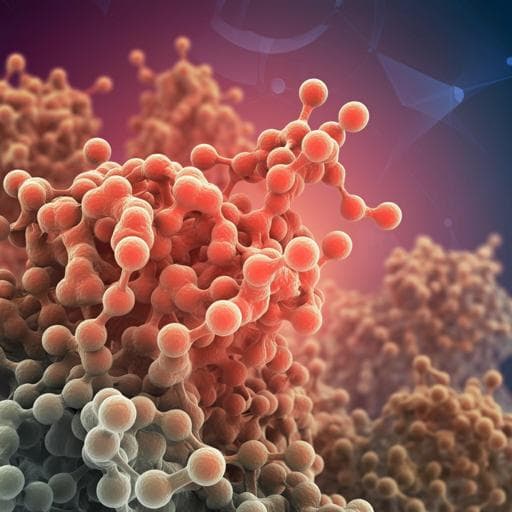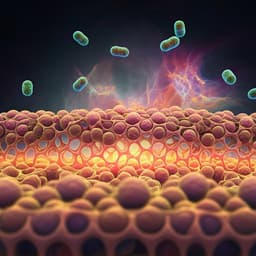
Food Science and Technology
Lipid complexation reduces rice starch digestibility and boosts short-chain fatty acid production via gut microbiota
Y. Shen, Z. An, et al.
This study by Yi Shen and colleagues explores how lipid complexation can enhance the digestibility of rice starch and boost the production of short-chain fatty acids. Findings reveal that rice varieties with higher lipid content not only exhibit lower digestibility but also result in greater SCFA concentrations during fermentation. Experience the fascinating connection between diet, digestion, and gut microbiota in this insightful research.
~3 min • Beginner • English
Introduction
Rice starch is rapidly digested, contributing to high glycemic index foods linked to metabolic diseases. Strategies to slow starch digestion include breeding high-resistant starch (RS) varieties and processing approaches such as complexation with lipids, proteins, or polyphenols. Lipids can insert their hydrophobic chains into amylose helices to form V-type amylose–lipid complexes (RS type 5, RSV) that resist small-intestinal amylolysis and reach the colon. RS modulates gut microbiota and increases short-chain fatty acids (SCFAs), but the colonic fermentation of rice-derived RSV and its gut health effects are understudied. Moreover, many prior studies tested starch–lipid complexes without prior gastrointestinal digestion, which does not reflect physiological exposure of the microbiota. This study compares a naturally higher-lipid, higher-amylose rice (RS4) and a lower-lipid rice (GZ93), with and without palmitic acid complexation, to determine effects on starch digestibility and on microbiota-driven SCFA production under a workflow that includes standardized in vitro digestion (INFOGEST) followed by fecal batch fermentation. The hypothesis is that higher lipid–amylose complexation reduces digestibility and selectively modulates the microbiota to enhance SCFA production.
Literature Review
Prior work shows that exogenous lipid–starch complexation lowers starch digestibility and forms resistant structures that reach the colon as RSV. Different RS types variably alter gut microbial composition and SCFA profiles, with increases typically in acetate, propionate, and butyrate. In vitro studies reported increased SCFAs when starch is complexed with saturated fatty acids; in vivo RS consumption elevates butyrate and may reduce glycemic responses, suggesting metabolic benefits. However, rice-derived RSV fermentation remains little explored, and many studies lacked a preceding digestion step, limiting physiological relevance. Triglycerides are sterically hindered for complex formation relative to free fatty acids like palmitic acid, justifying the choice of palmitic acid here.
Methodology
Study design: Two rice varieties were used: RS4 (apparent amylose 44.7%, higher lipid) and GZ93 (apparent amylose 16.4%, lower lipid), derived via gamma irradiation selection. White rice flours were prepared and starch isolated by alkaline washing with subsequent neutralization and freeze-drying.
Complex preparation and characterization: Starch–palmitic acid complexes were prepared by mixing starch with water and palmitic acid, heating in boiling water for 30 min with intermittent shaking, then cooling to allow retrogradation and complex formation. Parallel flour and starch controls were prepared without palmitic acid. Thermal properties were measured by DSC (30–130 °C, 4 °C/min) to detect amylose–lipid complex melting and quantify enthalpies.
In vitro digestion: Samples were subjected to the standardized INFOGEST static digestion (oral, gastric, intestinal phases with specified enzymes and conditions). During the intestinal phase, aliquots were collected over 0–180 min, stopped with ethanol, treated with amyloglucosidase, and glucose quantified (GOPOD). Starch digestibility curves were fitted to a first-order model to estimate the extent at infinite time (C∞) and rate constant k. Post-digestion residues were recovered, and remaining starch content quantified.
In vitro fermentation: INFOGEST undigested fractions served as substrates in anaerobic batch fecal fermentations with two healthy adult donors. Each bottle contained fermentation medium, fecal inoculum, and substrate (blank, palmitic acid, native flour, starch, or starch–lipid complex). Incubations were at 37 °C with sampling at 0, 4, 24, and 48 h. SCFAs (acetate, propionate, butyrate) were measured by GC-FID with internal standardization. Time-series analyses, heatmaps, PCA and ASCA were conducted in MetaboAnalyst 5.0.
Microbiota profiling and functional prediction: DNA from 48 h fermentations was sequenced (16S rRNA V3–V4, Illumina MiSeq). QIIME2/DADA2 generated ASVs; alpha diversity (Shannon, Faith, Evenness) and beta diversity (weighted UniFrac PCoA) were assessed. Taxonomic composition was assigned with Greengenes. Functional potential was inferred using PICRUSt to obtain KEGG ortholog enrichment. To link taxa with metabolites, MIMOSA2 integrated microbiome and SCFA data to compute community metabolic potential (CMP) and identify taxa contributing to SCFA variance using AGORA and EMBL_GEMs metabolic model databases. Statistics: triplicates, one-way ANOVA with Duncan test (p<0.05).
Key Findings
Composition and complexation: RS4 flour had higher protein (7.82%) and lipid (2.23%) than GZ93 flour (protein 5.87%, lipid 0.79%). Isolated starches had minimal protein (RS4 1.10%, GZ93 0.50%) and lipids (RS4 0.62%; GZ93 not detected). After complexation with palmitic acid, lipid content in both RS4 and GZ93 complexes rose to ~9.65%, indicating efficient complex formation. DSC showed characteristic amylose–lipid complex melting peaks; enthalpy (ΔH) associated with the complex was higher in RPA (RS4 complex, 12.1 J/g) than GPA (GZ93 complex, 3.7 J/g), consistent with RS4’s higher amylose and ligand availability.
Digestibility: Starch–lipid complexes reduced digestibility. Relative to respective flours and starches, GPA had 11.5% and 17.7% lower C∞ than GN and GS; RPA had 24.7% and 18.5% lower C∞ than RN and RS. Remaining starch in undigested fractions was higher for complexes (RPA 0.42 g/g; GPA 0.32 g/g) than for non-complexed samples (RS 0.28; RN 0.30; GS 0.20; GN 0.24), indicating more RSV formation.
SCFAs: Palmitic acid alone did not alter SCFA production vs blank. Complexed samples showed distinct fermentation profiles, with significantly higher acetate and propionate at 4, 24, and 48 h compared to flour/starch. At 24 h, RPA reached 15.19 mM acetate and 24.71 mM propionate, exceeding GPA (12.03 mM acetate; 16.76 mM propionate). RS4 (RN, RS) produced more acetate and propionate than GZ93 (GN, GS). By 48 h, acetic and propionic acids comprised >70% of total SCFAs; uniquely, complexes produced more propionate than acetate.
Microbiota: Starch–lipid complexes reduced alpha diversity (Shannon/Evenness) without reducing richness (Faith) and produced distinct beta-diversity clustering from flour/starch and blank. Complexes increased Bacteroidetes, Proteobacteria, and Fusobacteria and decreased Firmicutes. Genus-level shifts included higher Bacteroides, Parabacteroides, Phascolarctobacterium, Fusobacteriaceae, and Enterobacteriaceae, with lower Sutterella, Dorea, Ruminococcus, Paraprevotella, Faecalibacterium, Clostridium, Eggerthella, Dialister, and Rikenellaceae. Microbial composition differences were driven more by RSV content than by total remaining starch.
Functional predictions and microbiome–metabolite links: PICRUSt predicted higher fructose/mannose and pyruvate metabolism and lower starch/sucrose metabolism in complexes, aligning with observed SCFAs. MIMOSA2 CMP scores significantly predicted SCFAs: positive associations for acetate and butyrate and a strong negative association for propionate (R² ≈ 0.542), likely reflecting model constraints and/or feedback inhibition. Enterobacter kobei contributed to acetate variation; taxa such as Flavonifractor plautii and Alistipes shahii were implicated in propionate variation; Dorea longicatena, Ruminococcus obeum, and Alistipes putredinis influenced butyrate dynamics.
Discussion
The study demonstrates that forming amylose–palmitic acid complexes (RSV) substantially reduces rice starch digestibility, thereby increasing the fraction that reaches the colon for microbial fermentation. This directly addresses the goal of lowering glycemic potential while enhancing microbiota-mediated benefits. The complexes selectively modulated the gut microbiota toward taxa and functions associated with carbohydrate degradation routes feeding into pyruvate and SCFA production, resulting in robust increases in acetate and propionate. The effect was more pronounced in the higher-amylose, higher-lipid RS4 background, underscoring the combined roles of breeding for amylose/lipid traits and processing via lipid complexation. Beta-diversity patterns support that RSV content, rather than overall residual starch, drives community restructuring. MIMOSA2 analyses provided mechanism-supported links between taxa and SCFAs, even revealing a negative but strong association for propionate that may reflect model limitations or ecological feedbacks. Collectively, these findings suggest that rice starch–lipid complexation could be leveraged to design lower-digestibility staples that foster SCFA production and potentially confer metabolic benefits.
Conclusion
Complexing rice starch with palmitic acid efficiently forms RSV, lowers in vitro starch digestibility (reduced C∞, higher residual starch), and enhances microbiota-driven SCFA production, especially acetate and propionate, while reshaping the gut microbial community and its functional potential. RS4, a higher-amylose, higher-lipid variety, showed stronger effects than GZ93, indicating synergistic benefits of intrinsic grain traits and processing. These insights support starch–lipid complexation as a strategy to modulate glycemic properties and gut microbiota activity. Future work should include mechanistic in vitro and in vivo studies to validate health outcomes, clarify host–microbe interactions (including epithelial responses), broaden donor diversity, and refine metabolic modeling to better capture propionate pathways.
Limitations
The experiments were conducted in vitro, which may not fully reflect in vivo digestion, absorption, and host responses. Only two human fecal donors were used, potentially limiting generalizability. Functional inferences relied on 16S-based predictions (PICRUSt) rather than shotgun metagenomics and on metabolic models (AGORA, EMBL_GEMs) with noted constraints, contributing to the observed negative CMP–propionate association. Only palmitic acid was tested as the complexing lipid; other fatty acids or lipid classes may yield different outcomes. Static INFOGEST conditions and batch fermentation do not mimic dynamic gastrointestinal transit and continuous colonic conditions.
Related Publications
Explore these studies to deepen your understanding of the subject.







